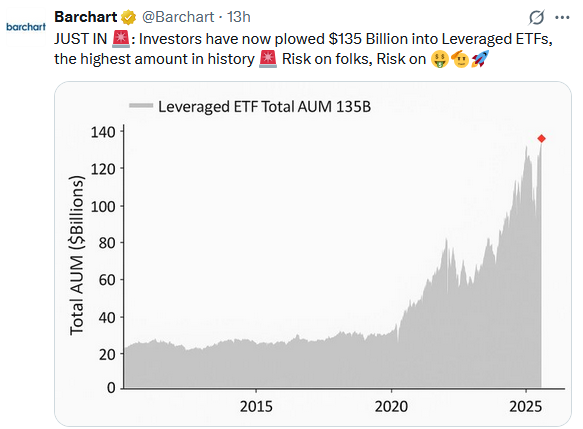IonQ CRO Alameddine Rima sells $4.6m in shares
Jerome Powell has made it clear that tariffs could induce higher inflation. Accordingly, the Fed has resisted cutting interest rates. Despite his concerns, fears of tariff-based inflation, as judged by individual and business surveys, are fading. Moreover, even some Fed members are backing away from their prior outlook that inflation would be transitory due to the effects of tariffs.
As tariff fears subside, is immigration the new inflation concern for the Fed? To help us better appreciate how President Trump is impacting immigration and the labor market, we share the insight of Greg Valliere, a long-time Washington, DC insider. The following are quotes from his daily newsletter:
- BE CAREFUL WHAT YOU WISH FOR: The White House has been demanding the deportation of immigrants, ASAP — but that may backfire as hundreds of thousands of workers flee, leaving crops rotting in the fields and hotels without enough employees.
- THE LABOR MARKET HAS BEEN TIGHT for the past few years, but not like this. The epicenter is in California, where workers are scarce as they leave the state in droves.
- THE IMMIGRATION SHORTAGE HAS AFFECTED FIRMS like Disney (NYSE:DIS) and Walmart (NYSE:WMT) as their workers’ temporary legal status has been revoked. This has prompted firms to hike their salaries and benefits, and has led to the inevitable fear of inflation.
- THERE’S LITTLE DOUBT ON ONE POINT: illegal border crossings have plummeted to the lowest levels in decades, accompanied by the realization that the economy needs more waiters, farm labor, construction workers, etc.
- THIS IS A MAJOR REASON WHY FED CHAIRMAN JEROME POWELL is tentative. The economy is softening in much of the country as crops lie fallow in the fields and new tariffs loom, probably on Aug. 1. It’s a confusing climate, and confusion is not a friend of the markets.
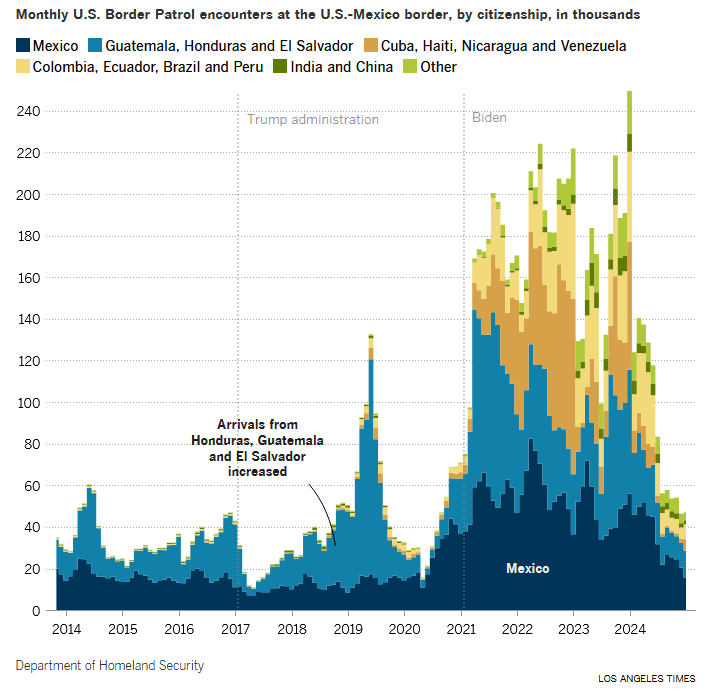
What To Watch Today
Earnings
- No earnings reports today
Economy
- No notable economic reports today
Market Trading Update
Yesterday, we discussed the rise in market complacency. With the market pushing back toward new highs, driven by underlying momentum, several technical indicators now point toward short-term overbought conditions and a rising risk of consolidation or a pullback in the coming weeks.
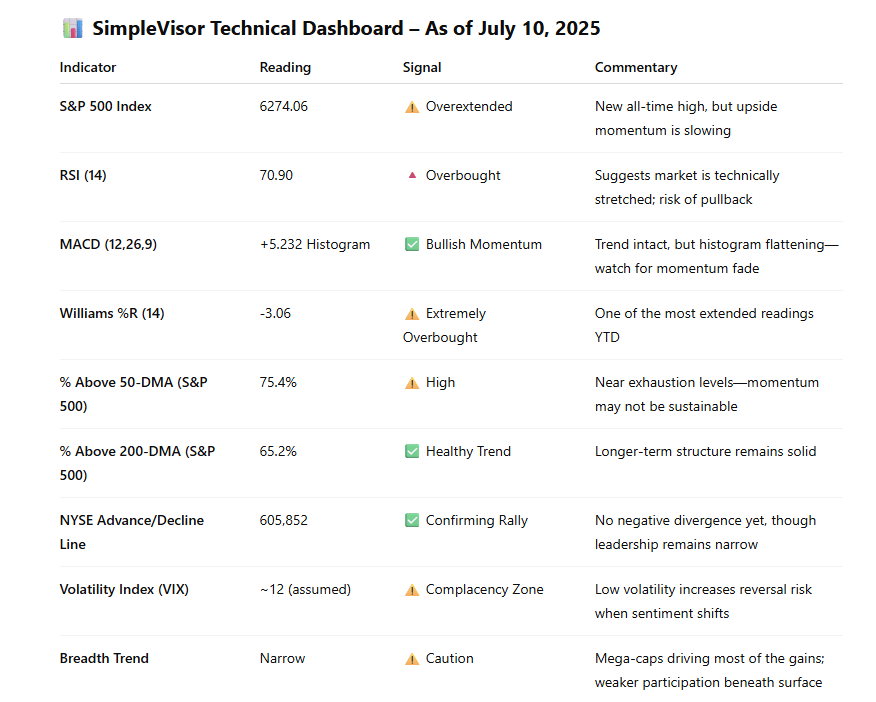
Given those more overbought technical conditions, the market could enter a period of sideways consolidation or a mild pullback in the next 2–4 weeks. The catalyst for such a correction is unknown, but when markets are very complacent, a reason usually appears in short order. Given elevated RSI and Williams %R, upside is likely capped in the near term unless macro or earnings catalysts re-accelerate buying interest.
If economic or earnings data disappoints, the S&P 500 could retrace toward the 50-day moving average (~6050–6100 range) before stabilizing.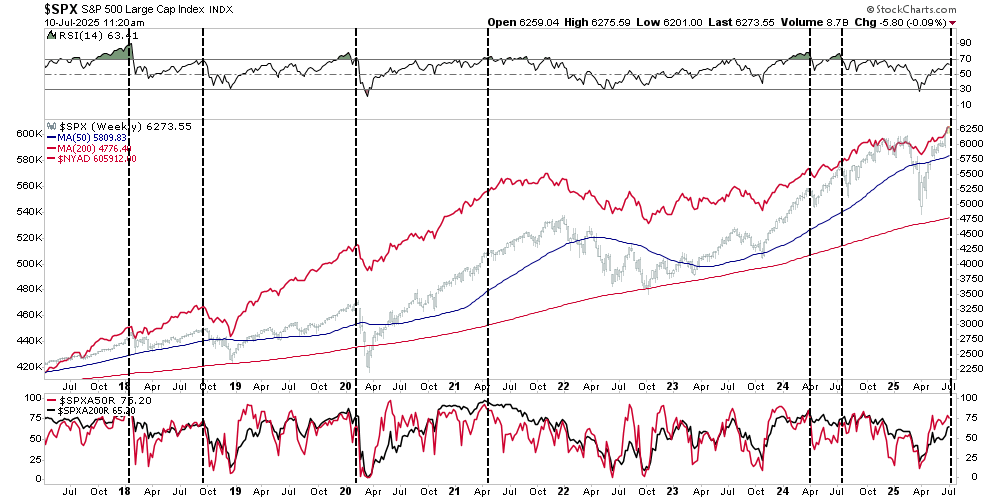
However, the uptrend remains intact for now, with breadth indicators still supportive and the MACD in bullish mode. Any weakness should be treated as tactical and rotational, rather than the start of a broader downtrend—unless A/D and moving average participation begin to deteriorate.
What Investors Should Do Now:
- Trim exposure in overbought/high-beta names, particularly those with large recent gains or extended valuations (e.g., speculative tech, meme stocks, or leveraged ETFs).
- Raise modest cash buffers (5–10%) to take advantage of pullbacks or rotation opportunities into lagging sectors like financials, healthcare, or industrials.
- Tighten stop-losses on momentum positions and consider partial profit-taking in sectors trading well above trend lines.
- Rebalance toward quality: favor companies with earnings visibility heading into Q2 earnings season. Focus on strong free cash flow, pricing power, and margin resilience.
- Watch breadth: if % of stocks above 50-DMA begins to decline while the index holds or rises, that would be a red flag for market fragility.
Notably, the market remains bullish. A short-term pause or pullback should be expected, but as long as breadth metrics hold up, the longer-term trend remains intact. Investors should take this time to lock in gains, reallocate capital to underperforming but fundamentally sound areas, and remain flexible as we head into Q2 earnings and the seasonally volatile August–September window.
Delta Soars
Delta Air Lines (NYSE:DAL) kicked off the earnings season by opening up over 10% on a promising earnings report. Earnings slightly beat estimates, but investors seem to be more motivated by optimism from its CEO, Ed Bastian. To wit, the following quote from Bastian on CNBC:
I think we have plenty of green shoots out there to give us some room of optimism that we’re going to be able to continue moving through this period of time, and we’ll still be profitable this quarter.
- Delta reinstated its profit target to a range of $5.25 to $6.25 per share, which is higher than the Wall Street consensus estimate of $5.35. However, the prior corporate guidance had been for earnings to exceed $7.35 per share.
- They report that air travel demand has stabilized after a period of weakness. Importantly for their bottom line, the uptick in demand is coming from premium and international travelers.
- Its concerns over tariffs, immigration policy, and the resulting weak consumer sentiment have eased.
The graphs below, courtesy of SimpleVisor, provide a longer-term perspective of Delta’s fundamental condition. The first graph shows that over the longer run, Delta steadily grows its revenue at about 6%, slightly more than the nation’s economic growth rate. However, its net income has been flat for the last ten years, and its stock price has been volatile, but is not much higher than it was in 2015.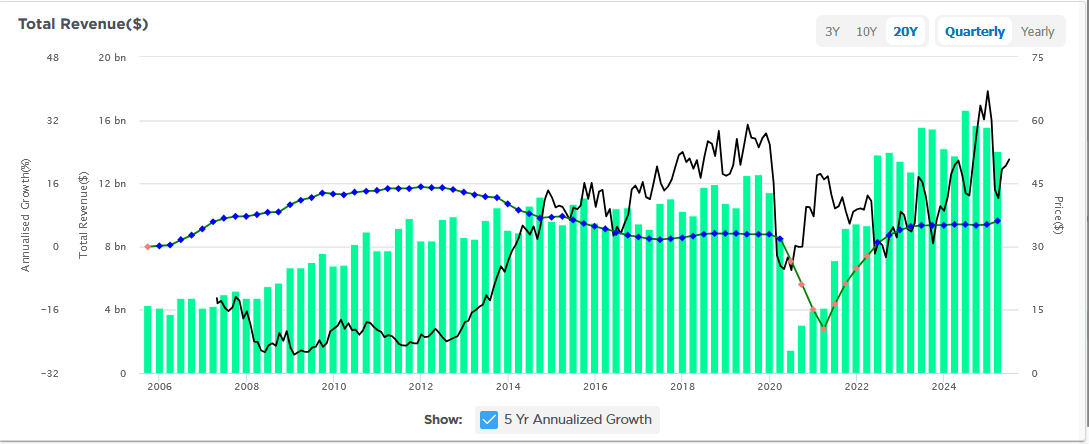
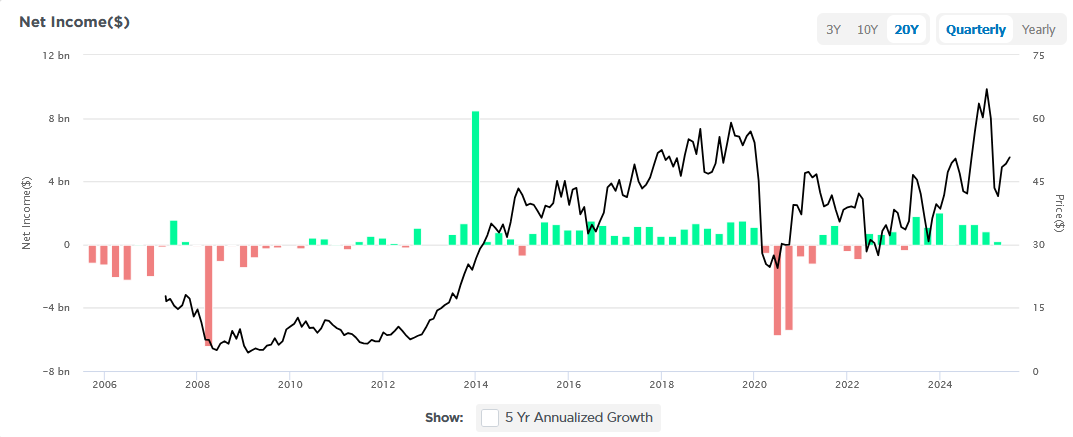
Tweet of the Day
